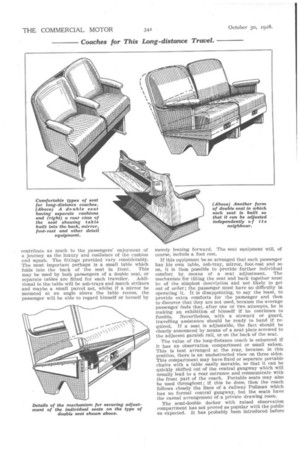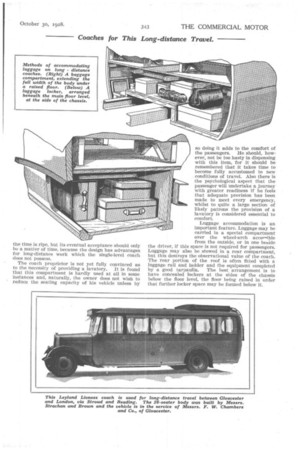COACHES FOR THIS
Page 21

Page 22

Page 23

If you've noticed an error in this article please click here to report it so we can fix it.
LONG-DISTANCE TRAVEL.
THE long-distance coach has rapidly increased in numbers during the last twelve months and many inquiries are now being made for additional vehicles. It is evident that the public likes this form of travel, but it is recognized that there is always room for improvement so that the long-distance vehicle shall be even better fitted for its special work and continue to attract an ever-widening circle of patrons.
A shapely exterior is required, closely resembling the private saloon in its outline and general features. The flat, mechanically operated door of the service bus usually gives place to the private car pattern, that is, one having a side sweep and turnunder and which opens outward. A domed back panel is, as a rule, regarded as another essential, whilst the main panels are fully extended below the chassis.
The forward-control type of chassis is as popular as the normal pattern, for body space is valuable, every inch being required to give plenty of leg-room, whilst buffet, lavatory and luggage compartments may have to be included in the planning. But, for elegance, the chassis with the conventional type of steering has the advantage, because there is the opportunity, with the modern passenger-type chassis, of introducing a comparatively large scuttle dash which helps to set off the lines of an imposing and well-proportioned bonnet.
The main entrance is at or near the front. If it be set well back from the windscreen so that there is a window between the door and the triangular end window of the screen, then the first side pillar has no door pillar beside it; consequently a lighter and less bulky effect is obtained in front. The emergency exit is not much used for the long-distance coach, but rather two entrances, usually both on the near side.
The seats must be as comfortable as space and ingenuity will permit. The first essential is that individual seating shall be provided as far as possible. To this end the backs of the seats are separately shaped, but this is also to be found on some service buses. The next refinement is the provision of side armrests to the double seat, then central armrests, or one on each side of each passenger. Although a double seat may have an individually shaped back rest, it does not always have individual cushions, an item which, however, should not entail much extra expense, especially if a standard size of cushion were adopted, which could be used also for any single armchairs provided.
The equipment of the seat is a factor which may contribute as much to the passengers' enjoyment of a journey as the luxury and resilience of the cushion and squab. The fittings provided vary considerably. The most important perhaps is a small table which
folds into the back of the seat in front. This may be used by both passengers of a double seat, or separate tables are fitted for each traveller. Additional to the table will be ash-trays and match strikers and maybe a small parcel net, whilst if a mirror be mounted at an angle above the table recess, the passenger will be able to regard himself or herself by
merely leaning forward. The seat equipment will, of course, include a foot rest.
If this equipment be so arranged that each passenger has his own table, ash-tray, mirror, foot-rest and so on, it is then possible to provide further individual comfort by means of a seat adjustment. The mechanism for tilting the seat and back together must be of the simplest description and not likely to get out of order; the passenger must have no difficulty in operating it. It is disappointing, to say the least, to provide extra comforts for the passenger and then to discover that they are not used, because the average passenger feels that, after one or two attempts, he is making an exhibition of himself if he continues to fumble. Nevertheless, with a steward or guard, travelling assistance should be ready to hand if required. If a seat is adjustable, the fact should be clearly announced by means of a neat plate screwed to the adjacent garnish rail, or on the back of the seat.
The value of the long-distance coach is enhanced if it has an observation compartment or small saloon. This is best arranged at the rear, because. in this position, there is an unobstructed view on three sides. This compartment may have fixed or separate portable chairs with a table easily movable, so that it can be quickly shifted out of the central gangway which will usually lead to a rear entrance and communicate with the front part of the coach. Portable seats may also be used throughout ; if this be done, then the coach follows closely the lines of a railway Pullman which has no formal central gangway, but the seats have the casual arrangement of a private drawing room.
The semi-double decker with raised observation compartment has not proved as popular with the public as expected. It has probably been introduced before
the time is ripe, but its eventual acceptance should only be a matter of time, because the design has advantages for long-distance work which the single-level coach does not possess.
The coach proprietor is not yet fully convinced as to the necessity of providing a lavatory. It is found that this compartment is hardly used at all in some instances and, naturally, the owner does not wish to reduce the seating capacity of his vehicle unless by so doing it adds to the comfort of the passengers. He should, however, not be too hasty in dispensing with this item, for it should be remembered that it takes time to become fully accustomed to new conditions of travel. Also there is the psychological aspect that the passenger will undertake a journey with greater readiness if he feels that adequate provision has been made to meet every emergency, whilst to quite a large section of likely patrons the provision of a lavatory is considered essential to comfort.
Luggage accommodation is an important feature. Luggage may be carried in a special compartment over the wheel-arch accee,4ible from the outside, or in one betide the driver, if this space is not required for passengers. Luggage may also be stowed in a rear compartment, but this destroys the observational value of the coach. The rear portion of the roof is often fitted with a luggage rail and ladder and the equipment completed by a good tarpaulin. The best arrangement is to have concealed lockers at the sides of the chassis below the floor level, the floor being raised in order that further locker space may be formed below it.


















































